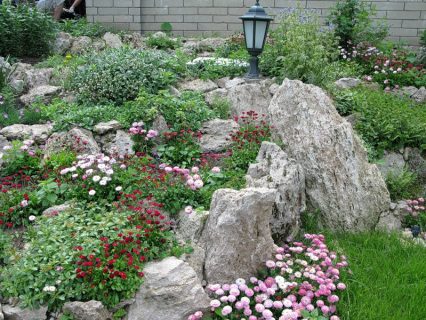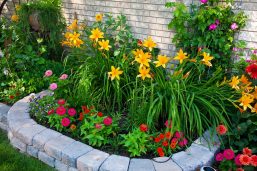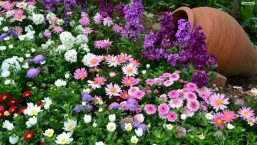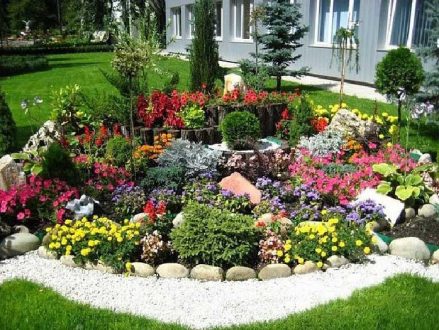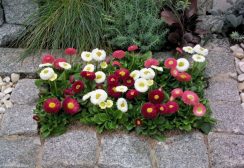Beloved by flower growers, these little "pearls" (translated from Greek as "margarita" means "pearl") are unpretentious. We decided to breed daisies - planting and care in the open ground will not take much time. But growing perennial daisies will be successful when certain rules are followed.
Material Content:
Planting and growing daisies in the open field

Daisies can be kept at home in flower pots. But their main place is in garden beds.
Planting Daisies Seedlings
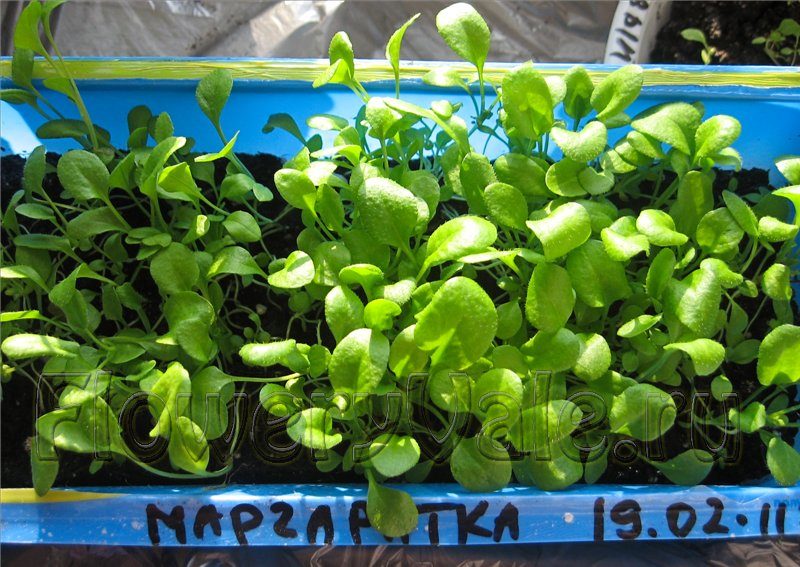
Many gardeners prefer to plant daisies in open ground with seedlings that they have grown themselves or bought in the market. In this case, one wonders whether the seeds will come up or not, and when buying, you can choose strong healthy seedlings of the desired variety.
Small bushes are planted as soon as the soil warms up. In central Russia, this happens in mid-May. When planting, you need to try to save the earth around the roots. The desired distance between the plants is 12-15 cm. Then green settlers are watered, the earth is compacted around each bush, and ideally they are sprinkled with mulch. Mulching protects the soil from drying out, contributes to the fact that moisture will be saved, and weeds will not grow.
With the threat of frost, young daisies are covered with a film for the night.
Division, cuttings
The flower grower can also increase his bed with daisies by dividing the existing adult bushes.This is usually done when the plant is in its third year, and you need to rejuvenate it.
Daisies are shared in July.
One bush can be "sorted" into 9-10 small ones.
Somewhat earlier, in May and June, it is easy to propagate your daisies using cuttings. Leaves are cut off from plants. After that, the leaves are planted - either in open ground, or in flower pots. It is advisable to use covering material for the first time, or cover the leaves with glass jars. Usually, the roots appear within two weeks, and the next year the daisies begin to bloom.
Propagation of daisies by seeds in the open field
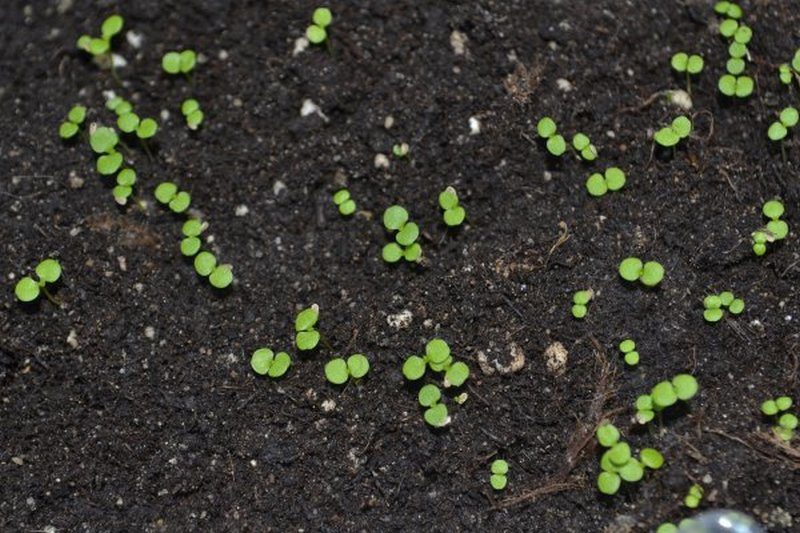
Propagation of daisies by seed has its advantages. You can sow seeds collected from your plants. Or inexpensively buy daisies of any kind.
They plant daisy seeds in June, preferably by the end of the month. The soil should be well loosened. The seeds are sown shallow, literally sprinkled on top of the ground. And shoots appear after 9-10 days. Thicken seedlings dive.
If we are talking about biennial daisies, then flowering can be expected only next summer. The seeds of annual varieties are planted in pots in the middle of winter and in the spring transplanted to a permanent place. In this case, daisies bloom in the year of sowing seeds.
After sowing, the bed is covered with a film. It must be raised regularly, make sure that the earth does not dry out, and if necessary, water.
Permanent transfer
Young plants are transplanted to a permanent place approximately 25-30 days after the dive. The most important thing in this case is not to damage the delicate roots. Therefore, plants are extracted from the ground along with a lump of earth. Wells should be prepared in advance, and the optimal distance between them is 15-20 cm. After that, daisies are watered - it is better to use settled, not too cold water.
Site selection for daisies, soil requirements
To the delight of everyone who loves these flowers, daisies are by no means capricious. Best of all, they will grow in well-lit beds, but will bloom, even if they are planted in a shady area.
But it is advisable to take care of the soil, especially if on the site it is heavy, clay. Daisies will grow and not hurt only on light, drained soil in which moisture does not stagnate. But the sandy soil on the bed is also not good. To saturate it with the substances necessary for the life of the plant, compost, peat, ash are added to it.
Outdoor Daisy Care
Whether daisies will bloom abundant and long depends on the care of the plants.
Watering, fertilizing and fertilizing daisies

The most vulnerable place in daisies are roots that are not deep underground. Therefore, it is especially important to ensure that the soil does not dry out, does not crack. Plants are regularly watered - if the bed is covered with mulch - this can be done less often.
Loosening helps air and moisture gain access to the roots. Therefore, after watering, the soil is carefully loosened.
Fertilizers can be applied in the spring - directly in the garden, reserved for daisies. And for the season to feed the plants another 2-3 times.
How and what to feed
As soon as the snow melts, you can spread the urea in the area. At this time, daisies are especially active in growing; therefore, they need nutrients. In summer, they feed with any fertilizer for flowers, diluted with manure.
Diseases, pests and control methods
The most common diseases affecting daisies are:
- Bronze leaf. Viral disease. You can suspect it if you see that the leaves are partially discolored, holes have appeared on them. Some leaves wrinkle, the flowers lose their shape. Plants affected by the disease must be destroyed;
- Powdery Mildew. This ailment is easy to recognize: a plaque is visible on the leaves - white, resembling flour. If you try to rub this place, you will see that under the powdery spot the leaf has turned brown. It is best to plant those varieties of daisies that are resistant to powdery mildew. If the disease has not yet spread, use the preparations Fitosporin-M, Topaz, Chistotsvet;
- Brown spotting. Light spots, appearing in single copies, quickly cover the leaves. Copper oxychloride helps to stop the disease;
- Gray rot. It seems that the affected areas literally fall apart under the fingers. Affected leaves should be removed, if possible, protect the plants from moisture with a film. Do not water. For the treatment of diseased daisies, you can use the drug Chistotsvet;
- Rust. The name speaks for itself - as if the leaves rust. You need to immediately cut them off. The Topaz drug will help, you can use the Bordeaux mixture.
In addition, pests pose a threat to daisies. It:
- Spider mite. You can suspect his attack on daisies by the appearance of specks on the leaves, which have a yellowish tint. Affected areas gradually dry out. You can treat the plants from the spray with a soap solution. In the absence of effect, use special drugs to combat ticks, such as Fitoverm;
- Caterpillars. Holes appear on the leaves. It is best to regularly inspect plants and collect caterpillars. If the bed is large, you can treat the plants with Fufanon, Tzipi and others;
- Thrips. Individual parts of the leaves turn yellow, and dark smudges appear on their underside. Thrips are tiny insects that are especially active when the weather is wet. You can get rid of them with sticky traps.
Daisy care after flowering
In order for plants to successfully survive the winter, you need to take care of them after flowering.
It is interesting:long-term care for eustoma
Preparing for wintering perennial daisies
Plants tolerate frosts pretty well. Trimming them in the fall is not required. The roots are still the most vulnerable part. To protect them, it is advisable to add peat under each plant.
How and when to collect daisy seeds?
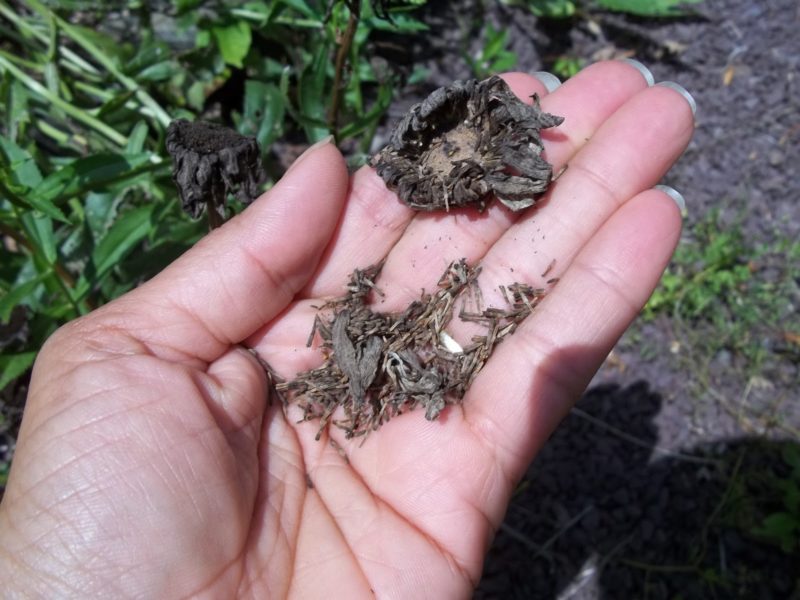
Many gardeners prefer to collect seeds from their daisies. It is necessary to take fading inflorescences and dry them. This can be done by spreading the newspaper on the windowsill. Seeds are stored in a dry place, sown on seedlings, starting in March.
We must not forget that daisies will bloom only next year.
Daisy in landscaping
Daisies are not suitable for bouquets, but with their help you can significantly decorate the garden.
Beautiful spring compositions, which include tulips, daffodils and daisies. You can plant "pearls" next to forget-me-nots and ferns. Daisies are also part of the "Moorish" lawns. But it is best to use them for flowerbed borders.
If you want to have fresh flowers in winter - remember that daisies are suitable for “forcing”.
With proper care, beautiful daisies will delight you with abundant flowering every year.


